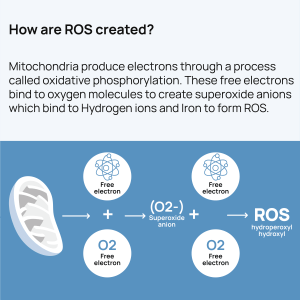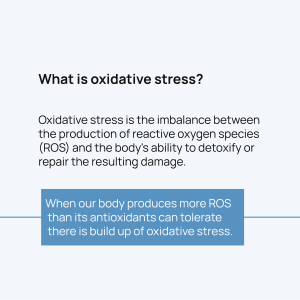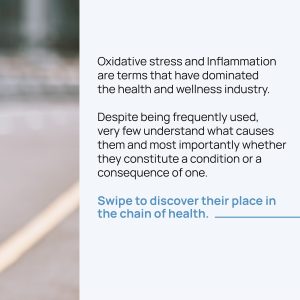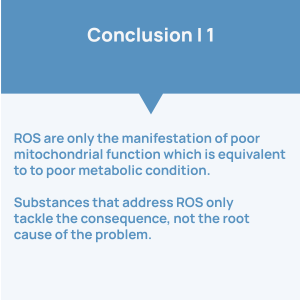What is Oxidative Stress?
Oxidative stress occurs when there is an imbalance between the production of free radicals (reactive oxygen species or ROS) and the body’s ability to neutralize them with antioxidants. Free radicals are highly reactive molecules with unpaired electrons, and they can cause damage to cells, proteins, lipids, and DNA, leading to various health problems.
How is Oxidative Stress Created as We Age?
-
Increased Free Radical Production:
- Mitochondrial Dysfunction: As we age, the efficiency of mitochondria (the cell’s powerhouses) decreases, leading to an increased production of free radicals.
- Environmental Exposures: Over time, exposure to environmental pollutants, UV radiation, and smoking can accumulate, contributing to increased free radical production.
- Metabolic Processes: Normal metabolic processes generate free radicals. With age, these processes can become less efficient, leading to higher free radical levels.
-
Decreased Antioxidant Defenses:
- Reduced Antioxidant Production: The body’s natural production of antioxidants, such as glutathione, decreases with age.
- Nutrient Deficiency: Aging can lead to reduced absorption of essential nutrients that have antioxidant properties, such as vitamins C and E, and zinc.
- Enzyme Function: The activity of antioxidant enzymes like superoxide dismutase (SOD), catalase, and glutathione peroxidase can decline with age.
How is Oxidative Stress Created in Athletes?
-
 Intense Physical Activity:
Intense Physical Activity:- Increased Oxygen Consumption: During intense exercise, the body’s oxygen consumption increases significantly, leading to a higher production of free radicals as a byproduct of increased metabolic activity.
-
Muscle Damage: Exercise, especially high-intensity or endurance exercise, causes microscopic damage to muscle fibers, prompting an inflammatory response and generating free radicals.
-
Temporary Imbalance:
- Acute Oxidative Stress: During and immediately after intense exercise, the production of free radicals can temporarily exceed the body’s antioxidant defenses, resulting in oxidative stress.
- Recovery Phase: During recovery, the body works to restore balance by repairing muscle damage and neutralizing excess free radicals.
Managing Oxidative Stress
-
For Aging Individuals:
- Balanced Diet: A diet rich in fruits, vegetables, nuts, seeds, and lean proteins can provide essential antioxidants.
- Regular Exercise: Moderate physical activity can enhance the body’s antioxidant defenses over time.
- Avoiding Toxins: Reducing exposure to environmental pollutants, quitting smoking, and limiting alcohol consumption can help manage oxidative stress.
- Supplementation: In some cases, antioxidant supplements may be recommended, but it’s essential to consult with a healthcare provider.
-
For Athletes:
- Nutrient-Rich Diet: Athletes should consume a diet high in antioxidant-rich foods to support recovery and reduce oxidative stress.
- Post-Exercise Nutrition: Including antioxidant-rich foods in post-exercise meals can help mitigate muscle damage and accelerate recovery.
- Balanced Training: Incorporating rest days and recovery periods into training schedules allows the body to repair and adapt.
- Professional Guidance: Consulting with a nutritionist or sports dietitian can help tailor antioxidant intake to individual training needs and goals.
In summary, oxidative stress results from an imbalance between free radical production and antioxidant defenses.
It increases with age due to metabolic inefficiencies and environmental exposures and in athletes due to intense physical activity.
Managing oxidative stress involves a combination of a healthy diet, regular exercise, and lifestyle choices that support the body’s antioxidant defenses.
What are Antioxidants?
Antioxidants are molecules that help neutralize free radicals, which are unstable molecules that can cause damage to cells, proteins, and DNA.
Free radicals are generated naturally in the body as byproducts of metabolism, and they can also be introduced through external sources such as pollution, radiation, cigarette smoke, and certain chemicals.
Why Take Antioxidants?
- For Aging:
- Combat Oxidative Stress: As we age, the accumulation of oxidative stress from free radicals contributes to the aging process and the development of age-related diseases. Antioxidants can help mitigate this damage by neutralizing free radicals.
- Cellular Health: By protecting cells from damage, antioxidants can help maintain healthier skin, reduce the risk of chronic diseases, and potentially improve longevity.
- Brain Health: Antioxidants can protect against neurodegenerative diseases such as Alzheimer’s and Parkinson’s by reducing oxidative damage to brain cells.
- For Athletes:
- Reduce Muscle Damage: Intense physical activity increases the production of free radicals, leading to oxidative stress and muscle damage. Antioxidants can help reduce this damage and promote faster recovery.
- Improve Performance: By reducing oxidative stress, antioxidants can enhance endurance and performance.
- Support Immune Function: Regular exercise can temporarily weaken the immune system. Antioxidants can support immune function, reducing the risk of infections and illnesses.
When to Take or Eat Antioxidants?
- Timing:
- With Meals: Many antioxidants are fat-soluble (such as vitamins A, D, E, and K), meaning they are better absorbed when consumed with dietary fat. Including antioxidant-rich foods as part of a balanced meal can enhance their absorption and effectiveness.
- Post-Exercise: For athletes, consuming antioxidants post-exercise can help reduce muscle soreness and speed up recovery. However, it’s important to note that excessive antioxidant supplementation immediately after exercise might blunt some of the beneficial adaptations to training, so a balanced approach is best.
- Regular Intake:
- Daily Basis: Incorporating antioxidant-rich foods into your daily diet ensures a steady supply of these beneficial compounds to help combat everyday oxidative stress.
- Variety of Sources: Consuming a variety of antioxidant-rich foods ensures you get a broad spectrum of antioxidants, as different types have different roles and benefits.
Best Practices:
- Balanced Diet: Focus on a balanced diet that includes a variety of fruits, vegetables, nuts, seeds, whole grains, and animal-based foods rich in antioxidants.
- Avoid Excessive Supplementation: While antioxidant supplements can be beneficial, it’s essential not to overdo them as excessive intake can sometimes have adverse effects.
- Consult with a Healthcare Provider: Especially for athletes and older adults, consulting with a healthcare provider can help tailor antioxidant intake to individual needs and health conditions.
In summary, antioxidants play a crucial role in combating oxidative stress, supporting cellular health, and promoting recovery and performance in athletes. Including a diverse range of antioxidant-rich foods in your diet on a regular basis can help maximize their benefits.
The Role of the Liver and Detox Pathways in Oxidative Stress
Liver’s Role:
Detoxification:
-
- Phase I Reactions (Oxidation, Reduction, Hydrolysis): The liver uses enzymes, primarily from the cytochrome P450 family, to transform lipophilic toxins into more hydrophilic substances. This process often generates free radicals as byproducts, contributing to oxidative stress.
- Phase II Reactions (Conjugation): In this phase, the liver attaches these transformed substances to molecules like glutathione, sulfate, or glucuronic acid to make them water-soluble for easier excretion.
- Glutathione, a potent antioxidant, helps neutralize free radicals.
-
Antioxidant Production:
- Glutathione: The liver synthesizes and regenerates glutathione, one of the body’s most important antioxidants.
- Glutathione neutralizes free radicals and reactive oxygen species (ROS), helping to protect cells from oxidative damage.
-
Nutrient Metabolism:
- Vitamin Storage and Activation: The liver stores and activates vitamins like A, D, E, and K, which have antioxidant properties.
- It also plays a role in the metabolism of iron and copper, whose excess can catalyze the formation of free radicals.
Detox Pathways:
-
Antioxidant Enzymes:
- Superoxide Dismutase (SOD): Converts superoxide radicals into hydrogen peroxide.
- Catalase: Converts hydrogen peroxide into water and oxygen, reducing oxidative stress.
- Glutathione Peroxidase: Uses glutathione to reduce hydrogen peroxide to water.
-
Phase III Reactions (Excretion):
- Transporters: The liver uses specific transporters to excrete the conjugated toxins into bile for elimination via the digestive tract or into blood for excretion by the kidneys.
The Role of Mitochondria in Oxidative Stress
Mitochondria’s Role:
- Energy Production:
- Electron Transport Chain (ETC): Mitochondria are the primary site of cellular respiration, where oxygen is used to produce ATP. During this process, electrons are transferred through the ETC, and a small percentage can leak out and react with oxygen to form superoxide radicals, a type of ROS.
- Free Radical Generation:
- ROS Production: As byproducts of ATP production, mitochondria continuously produce ROS. Under normal conditions, these ROS are kept in check by the cell’s antioxidant defenses. However, during stress or dysfunction, ROS production can increase significantly.
- Regulation of Apoptosis:
- Cytochrome c Release: When oxidative stress damages mitochondria, they can release cytochrome c into the cytoplasm, triggering programmed cell death (apoptosis). This process is crucial for removing damaged cells but can contribute to tissue damage if dysregulated.
Antioxidant Defense in Mitochondria:
- Mitochondrial Antioxidants:
- Manganese Superoxide Dismutase (MnSOD): Converts superoxide radicals produced in the mitochondria into hydrogen peroxide.
- Glutathione: Present in mitochondria to neutralize ROS.
- Thioredoxin and Peroxiredoxin: Enzyme systems within mitochondria that help reduce hydrogen peroxide and other peroxides.
- Liver and Detox Pathways: The liver plays a critical role in detoxifying harmful substances and neutralizing free radicals. It produces and regenerates antioxidants like glutathione, processes nutrients that have antioxidant properties, and uses enzyme systems to transform and excrete toxins, mitigating oxidative stress.
- Mitochondria: Mitochondria are central to energy production and are a primary source of ROS. They have intrinsic antioxidant systems to manage ROS and prevent oxidative damage. However, mitochondrial dysfunction can lead to increased ROS production and oxidative stress, contributing to cellular damage and aging.
Together, the liver and mitochondria work to balance free radical production and antioxidant defenses, protecting the body from oxidative stress and maintaining cellular health.
Here is a list of animal-based foods that are rich in antioxidants:
-
Fish and Seafood
- Salmon: High in astaxanthin, an antioxidant that gives salmon its pink color.
- Sardines: Contains selenium and other antioxidants.
- Mackerel: Rich in CoQ10 and selenium.
- Tuna: Contains selenium and omega-3 fatty acids.
-
Meat
- Grass-fed Beef: Contains higher levels of vitamin E and beta-carotene compared to grain-fed beef.
- Liver (especially beef liver): Rich in CoQ10 and vitamin A.
- Chicken (especially dark meat): Contains more CoQ10 compared to white meat.
-
Eggs
- Egg Yolks: High in lutein and zeaxanthin, which are important for eye health.
-
Dairy
- Grass-fed Butter: Contains higher levels of vitamin E and beta-carotene.
- Cheese (especially aged varieties): Rich in selenium and other antioxidants.
-
Shellfish

- Oysters: High in zinc and selenium.
- Mussels: Contains various antioxidants, including selenium.
-
Organ Meats
- Kidney: High in selenium.
- Heart: Rich in CoQ10.
- Organ Supplements as Paleo Valley, Body Health or Ancestral Supplements
These animal-based foods not only provide antioxidants but also other essential nutrients that support overall health. Including a variety of these foods in your diet can help ensure you get a broad range of antioxidants and other beneficial compounds.
